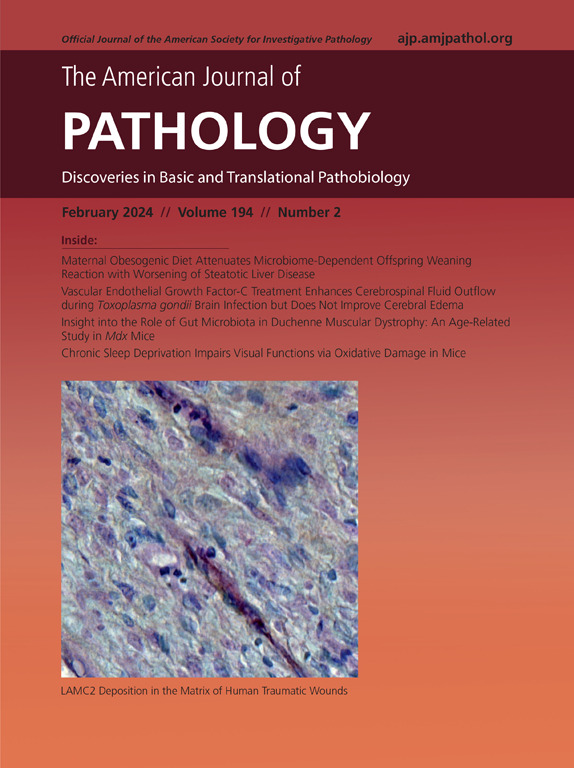乙型肝炎病毒表面抗原增强tnf α介导的肝细胞凋亡和肝损伤。
IF 3.6
2区 医学
Q1 PATHOLOGY
引用次数: 0
摘要
肿瘤坏死因子α (Tumor necrosis factor α, TNFα)是一种高度多效性的细胞因子,具有细胞增殖、代谢激活、炎症反应和细胞死亡等多种生物学功能。TNFα可诱导多种机制启动肝细胞凋亡,导致随后的肝损伤。HBsAg是慢性病毒感染时肝细胞中最丰富的HBV蛋白。然而,其在tnf α介导的肝细胞凋亡中的作用尚未被揭示。我们在这里报道,HBsAg通过抑制tnf α介导的抗凋亡复合物I依赖NF-κB的激活和增强tnf α介导的促凋亡复合物II的组装来促进tnf α介导的肝细胞凋亡。机制上,hbsag介导的复合物I组装抑制与通过抑制cIAP1表达下调K63-linked RIPK1泛素化有关。分泌不足的HBsAg变体S204R通过进一步抑制RIPK1泛素化来增强其促凋亡能力。重组腺病毒相关病毒8在小鼠体内的表达可促进d -半乳糖胺/脂多糖诱导的tnf α介导的肝损伤和损伤。总之,HBsAg可能通过将tnf α介导的抗凋亡复合体I转换为促凋亡复合体II,使肝细胞易发生tnf α介导的凋亡,并使小鼠易发生急性肝损伤,这为hbv相关肝损伤的潜在机制提供了新的见解。本文章由计算机程序翻译,如有差异,请以英文原文为准。
Enhancement of Tumor Necrosis Factor-α–Mediated Hepatic Apoptosis and Liver Injury by Hepatitis B Virus Surface Antigen
Tumor necrosis factor-α (TNF-α) is a highly pleiotropic cytokine with a variety of biological functions, such as cell proliferation, metabolic activation, inflammatory response, and cell death. TNF-α can induce a variety of mechanisms to initiate hepatocyte apoptosis, resulting in subsequent liver damage. Hepatitis B virus surface antigen (HBsAg) is the most abundant hepatitis B virus protein in the hepatocyte during chronic virus infection. However, its role in TNF-α–mediated apoptosis of hepatocytes has not been revealed. We report here that HBsAg promotes TNF-α–mediated hepatocyte apoptosis through inhibiting TNF-α–mediated anti-apoptotic complex I–dependent NF-κB activation and enhancing TNF-α–mediated pro-apoptotic complex II assembly. Mechanistically, HBsAg-mediated inhibition of complex I assembly was associated with down-regulation of K63-linked receptor-interacting protein kinase 1 (RIPK1) ubiquitination through repression of cellular inhibitor of apoptosis protein-1 (cIAP1) expression. Secretion-deficient HBsAg variant S204R enhances their pro-apoptotic abilities via further inhibition of RIPK1 ubiquitination. Expression of HBsAg in mice injected with recombinant adenovirus-associated virus 8 promoted D-galactosamine/lipopolysaccharide–induced TNF-α–mediated liver injury and damage by a mouse model. In conclusion, HBsAg may predispose hepatocytes to TNF-α–mediated apoptosis and mice to acute liver injury by switching TNF-α–mediated anti-apoptotic complex I to pro-apoptotic complex II, showing novel insights into the underlying mechanisms of hepatitis B virus–associated liver injury.
求助全文
通过发布文献求助,成功后即可免费获取论文全文。
去求助
来源期刊
CiteScore
11.40
自引率
0.00%
发文量
178
审稿时长
30 days
期刊介绍:
The American Journal of Pathology, official journal of the American Society for Investigative Pathology, published by Elsevier, Inc., seeks high-quality original research reports, reviews, and commentaries related to the molecular and cellular basis of disease. The editors will consider basic, translational, and clinical investigations that directly address mechanisms of pathogenesis or provide a foundation for future mechanistic inquiries. Examples of such foundational investigations include data mining, identification of biomarkers, molecular pathology, and discovery research. Foundational studies that incorporate deep learning and artificial intelligence are also welcome. High priority is given to studies of human disease and relevant experimental models using molecular, cellular, and organismal approaches.

 求助内容:
求助内容: 应助结果提醒方式:
应助结果提醒方式:


